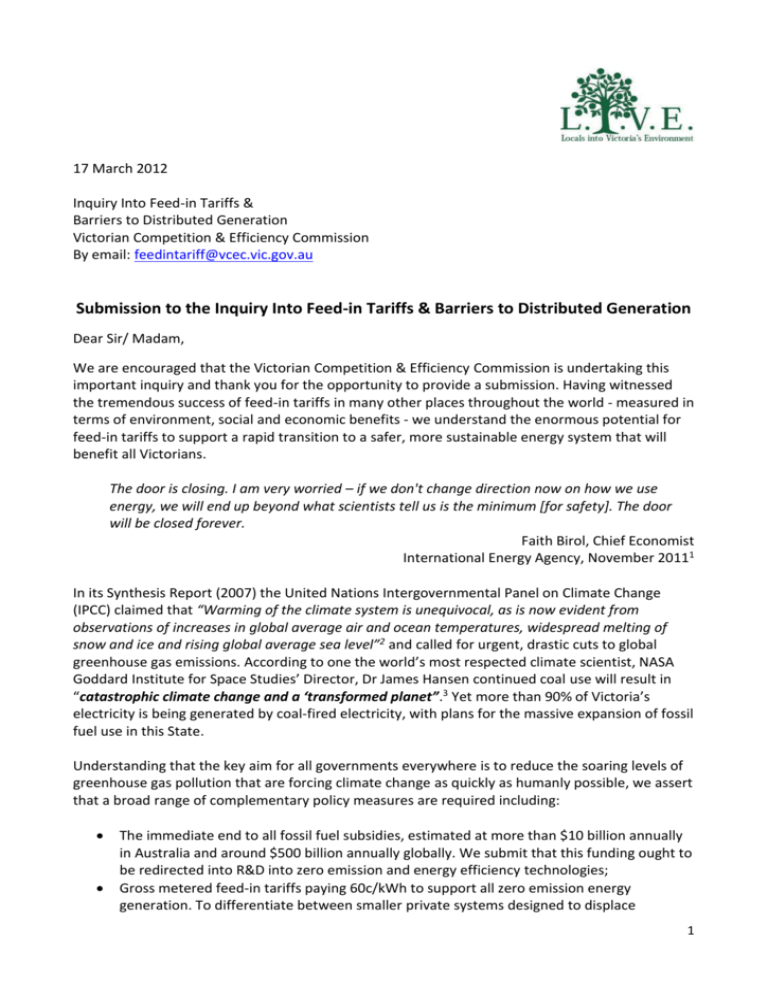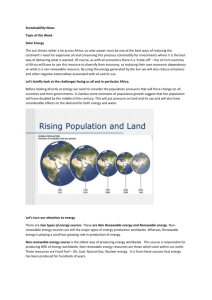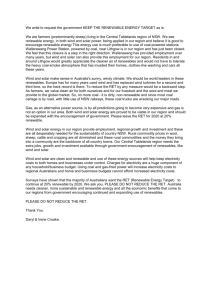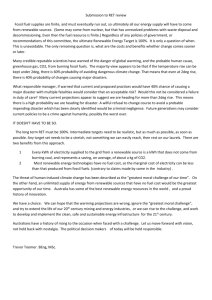LIVE (DOCX 58kb) - Victorian Competition and Efficiency Commission
advertisement

17 March 2012 Inquiry Into Feed-in Tariffs & Barriers to Distributed Generation Victorian Competition & Efficiency Commission By email: feedintariff@vcec.vic.gov.au Submission to the Inquiry Into Feed-in Tariffs & Barriers to Distributed Generation Dear Sir/ Madam, We are encouraged that the Victorian Competition & Efficiency Commission is undertaking this important inquiry and thank you for the opportunity to provide a submission. Having witnessed the tremendous success of feed-in tariffs in many other places throughout the world - measured in terms of environment, social and economic benefits - we understand the enormous potential for feed-in tariffs to support a rapid transition to a safer, more sustainable energy system that will benefit all Victorians. The door is closing. I am very worried – if we don't change direction now on how we use energy, we will end up beyond what scientists tell us is the minimum [for safety]. The door will be closed forever. Faith Birol, Chief Economist International Energy Agency, November 20111 In its Synthesis Report (2007) the United Nations Intergovernmental Panel on Climate Change (IPCC) claimed that “Warming of the climate system is unequivocal, as is now evident from observations of increases in global average air and ocean temperatures, widespread melting of snow and ice and rising global average sea level”2 and called for urgent, drastic cuts to global greenhouse gas emissions. According to one the world’s most respected climate scientist, NASA Goddard Institute for Space Studies’ Director, Dr James Hansen continued coal use will result in “catastrophic climate change and a ‘transformed planet”.3 Yet more than 90% of Victoria’s electricity is being generated by coal-fired electricity, with plans for the massive expansion of fossil fuel use in this State. Understanding that the key aim for all governments everywhere is to reduce the soaring levels of greenhouse gas pollution that are forcing climate change as quickly as humanly possible, we assert that a broad range of complementary policy measures are required including: The immediate end to all fossil fuel subsidies, estimated at more than $10 billion annually in Australia and around $500 billion annually globally. We submit that this funding ought to be redirected into R&D into zero emission and energy efficiency technologies; Gross metered feed-in tariffs paying 60c/kWh to support all zero emission energy generation. To differentiate between smaller private systems designed to displace 1 polluting energy and larger energy retailers aiming to profit from electricity generation, we suggest it is also appropriate for the expenses of installation for the former to be made tax deductible; The strengthening of Victoria’s mandatory renewable energy target (MRET) to encourage investment in large-scale renewable energy, schemes to reduce greenhouse gas emissions and to ultimately decrease the emission intensity of our State’s electricity system; A commitment to support a price on greenhouse gas emissions, one that reflects the true costs of the long term damage caused by burning fossil fuels; and Significant investment in forests and sustainable agriculture to draw down and sequester excess carbon out of the atmosphere and store it in sustainable sinks. It would seem that, like all other Australian governments, the Victorian government assumes that it is in the best interests of consumers for their energy systems to be privately owned and unregulated. Is there any other energy system in the world that is entirely unregulated and if so, in whose interests does this serve? Given what has occurred with deregulated financial markets, on what grounds can decision makers claim that an extremely low price on carbon pollution (although higher than the free market would set) in an otherwise unregulated energy market will best serve Australian energy consumers? How could any decision maker argue that a highly vulnerable carbon price of only $23 per tonne (under the Federal Clean Energy Future plan) will provide the incentives required to transition Australia’s energy system away from highly polluting fossil fuel energy to zero emission energy sources in time to prevent catastrophic impacts from climate change? By any measure, a faith in the invisible hand of the market to preserve our safe climate and environment, while delivering us safe, secure energy systems is simply preposterous. We suspect that the lack of vision, poor assumptions, and frequent errors and misinformation made in relation to renewable energy and energy efficiency, is as a direct result of the reference groups typically selected to advise governments on energy matters. Presuming that the Victorian Competition & Efficiency Commission is in a position to select its own panel of advisors for the Feed-in Tariff Inquiry, we suggest it appropriate to include people with expertise in renewable energy and energy efficiency. Further to this, given that Feed-in Tariffs have proven to play a key role in displacing polluting energy and achieving greater energy security in places that have adopted them, we consider it appropriate to also have representation from community and environment groups. The Green Economy is the Future Economy In recent years investments in renewable energy capacities and manufacturing have grown strongly and steadily, up from just $30 billion in 2004 to more than US$211 billion in 2010 (a 540 per cent increase).4 Since 2008 each year more money has been flowing into new renewable energy capacity than in new fossil fuel capacity5. This happened even while fossil fuel energy sources continue to enjoy massive public subsidies, a virtual monopoly of the energy market and the rights to freely pollute. Even in the heat of the Global Financial Crisis, the renewable energy industry grew by 32 per cent per annum worldwide. With such serious money now being injected into alternative technologies, all indicators are suggesting that a major transformation in the way the world makes and uses energy is well on its way. With only a fraction of our renewable energy resources, countries such as Germany, Spain, China, USA, and Japan, to name a few, are enjoying the social and economic benefits of a burgeoning 2 solar energy industry. As a result of a decade of feed-in-tariffs, solar power systems in Germany generated more than 18 billion kilowatt (KW) hours of electricity during 2011.6 Over just 12 days during December 2011, Germany installed more than three GW of solar PV.7 This represents more solar power than Australia has installed in its entire history. In terms of the social and economic benefits to be gained, as a direct result of introducing a suite of policy measures to encourage zero emission energy generation, by 2010 Germany had created more than 367,000 jobs in renewable energy and energy efficiency industries.8 Turning to China, in mid 2011 a national feed-in tariff was introduced for solar projects and the official growth forecasts for solar energy have nearly doubled to 50 gigawatts (GW) by 2020. Some analysts are conceding that, with the current rate of growth, and the quickening pace at which the cost economies are converging, China could be producing as much as 100GW of energy from solar PV by 2020.9 In many other places around the world solar energy is generating substantial new investment and new jobs in rural and regional areas while stabilising local greenhouse gas emissions and increasing energy security. In May 2011 the IPCC (aforementioned) published a special report for policymakers, demonstrating that by 2050 nearly 80% of the world’s energy supplies could be met by renewable energy.10 According to Beyond Zero Emissions peer reviewed report Zero Carbon Australia 2020 Stationary Energy Plan, within a decade Australia could change its stationary electricity system from polluting energy to zero emission energy using off the shelf renewable energy and energy efficiency technologies, all readily available now. The report reveals that such a transition would: 1) be feasible, 2) be affordable, 3) create an estimated 140,000 new jobs in regional economies (where they are needed most), and 4) ensure energy security in Australia for at least the next 70 years. It would use a dozen concentrated solar thermal plants in sites around Australia to provide approximately 60 per cent of our electricity, with wind power providing the remaining 40 per cent, and with 2 per cent coming from biomass and hydro as contingency. The cost to construct a zero emission energy infrastructure to secure our energy supplies for the next 70 or so years, will be around $37 billion a year over the next decade, which is 3 to 3.5 per cent of GDP or $8 per household per week. As its authors readily claim, the Zero Carbon Australia 2020 Stationary Energy Plan is not the only path to a low carbon economy but it demonstrates that it can be done. Also, it is worth noting that nearly all of the more than 50 experts who contributed to the plan have fossil fuel energy based backgrounds but would prefer to work with clean energy instead. We submit that the Victorian Competition & Efficiency Commission ought to be looking closely at this plan to ascertain what opportunities exist for Victorians in meeting a 100% renewable energy electricity system for Australia. There is no doubt that attractive Feed-in Tariffs offered in Victoria will attract and encourage new investment and jobs in solar energy in our state. As we have seen occur in other places, our community will gain demonstrable social and economic benefits, while quantifiably reducing greenhouse gas emissions through the displacement of dangerous fossil fuel based energy. Logically, if air conditioners were required to be powered using solar energy then we would have no more blackouts or brownouts during heat waves. And through the merit order, electricity prices overall would come down more than enough to cover the costs of the feed-in tariffs required to enable the widespread adoption of renewable energy. This is already happening in Germany. Unless we move quickly to develop our rich zero carbon energy resources, our reliance on coalfired electricity will not only continue to force dangerous climate change but will also ensure that 3 our economy falls behind because everything coming out of Victoria will carry an enormous carbon footprint at a time when world economies are transitioning away from polluting technologies and practices. There have already been reports from China, quoting Wu Yin, the deputy head of the government’s National Energy Administration, saying that China is looking to impose an absolute cap on coal energy consumption by 2015 – an innovative twist on global climate change policies that have so far included caps on emissions, Feed-in Tariffs, and renewable energy targets.11 Health Impacts of fossil fuel use vs solar energy Pollution from coal combustion has been directly linked to serious diseases including asthma, lung cancer, heart disease, and stroke. It interferes with lung development, increases the risk of heart attacks, and compromises intellectual capacity.12 Of major concern is that the particulate (that is very tiny) nature of dust pollution (from coal mining) is fine enough to enter the bloodstream through the lungs. Elevated rates of mortality, lung cancer and chronic heart, lung and kidney disease have all been reported among people living near coalmines.13 The calculation is that for every ten micrograms increase in the concentration of dust pollution from coal mining, the findings show a half-a-per cent increase in the mortality rate.14 Clearly, it is highly irresponsible for the Victorian government to allow and expansion of the mining and burning of coal in this State. We submit that an attractive Feed-in Tariff for solar energy could assist in redirecting investments in dirty fossil fuel based energy systems towards safe, zero emission solar technologies. Meeting 21st Century Challenges If the state of Victoria is to maintain living standards and quality of life for current and future generations, we must immediately commence a rapid transition away from ‘old’ centralised and highly polluting fossil fuel based infrastructure and energy sources towards ‘new’ decentralised and more sustainable alternatives. In addition to drastically reducing GHG emissions, the adoption of renewable energy sources located close to end power users will ensure a more robust and secure power supply than the current one. This is because centralised power supplies are more vulnerable to major disruptions caused by accidents, fires and storms (which are predicted by scientists to become even more frequent and ferocious15), accidents and/or deliberate attacks. We know the big test for Victoria, and indeed all places around the world, will be how to manage the twin challenges of climate change and peak oil. Climate change is here and our environment is already showing the predicted signs due to excessive GHG emissions in our atmosphere, as clearly demonstrated by our nation’s recent toll of tragic events. Further, the era of cheap crude oil for transportation is gone. Given the tyranny of distance and our increased vulnerability to draught and flooding, it is even more critical for all states in Australia to prepare for the changed economic and ecological circumstances that will be part of life in the 21 st Century. Given the billions Australians are now spending to mop up after successive climate related natural disasters, alternative technologies are looking cheaper and more attractive by the minute. A safe climate and healthy environment are the foundations on which all else we know and value depends. The most cited argument for slow and inadequate responses to climate change and peak oil, are driven by a combination of ignorance of the current science, greed by those with vested economic interests, fear of change and the failure to recognise the bountiful economic opportunities that are ready to be taken up. Climate deniers typically fall into one or more of the 4 categories above. Yet, as previously stated, with the adoption of renewable energy as a much greater proportion of our energy mix—in addition to mitigating catastrophic global warming— there will be the added benefit of a boost to our local economies and new, more secure and sustainable ‘green collar’ jobs in Victoria. Arguably the most effective policy tool to achieve a rapid, widespread uptake of solar energy in Victoria would be to offer gross metered Feed-in Tariffs of around 60c/kWh to reward generators for the safe, secure, zero emission energy they produce. Further, I emphasise the point that we only have to look at a few recent extreme weather events in Australia and around the world to appreciate that the cost of inaction far outweighs the cost of taking preventative measures. The more climate change we experience the more costly it will be for the nation and in turn our State’s economy. In concluding I wish to emphasize that this submission, along with numerous others located at http://www.live.org.au/submissions, has been prepared to voice the deep climate concerns of private citizens associated with LIVE (an inner Melbourne based, independent, non profit climate change action group representing more than 3,000 people). In other words, we have no vested interests, nobody is paying or compensating me in any way and there is nothing covert about LIVE’s access to our democratically elected representatives. Thank you for your attention to this submission. I would welcome the opportunity to discuss any part of this submission with you. Yours faithfully Deborah Hart LIVE Campaigner Website: www.live.org.au 1 http://www.guardian.co.uk/environment/2011/nov/09/fossil-fuel-infrastructure-climate-change ‘World headed for irreversible climate change in five years, IEA warns’ by Fiona Harvey, The Guardian, 9 November 2011 2 http://www.ipcc.ch/publications_and_data/ar4/syr/en/spms1.html 3 David Spratt and Phillip Sutton, Climate Code Red (Scribe Publications, 2008) 4 http://www.energymatters.com.au/index.php?main_page=news_article&article_id=1622 ‘Global Renewable Energy Investment Surged in 2010, Energy Matters, 8 July 2011 5 http://www.ren21.net/Portals/97/documents/GSR/REN21_GSR_2010_full_revised%20Sept2010.pdf REN21 Renewables 2010 Global Status Report, Forward by the Chairman 6 http://cleantechnica.com/2012/01/10/germany-installed-a-record-7-5-gw-of-solar-power-in-2011/ ‘Germany Installed a Record 7.5 GW of Solar Power in 2011’ by Joshua S Hill, CleanTechnica, 10 January 2012 7 ibid 8 http://www.bmu.de/files/english/pdf/application/pdf/ee_in_zahlen_2010_en_bf.pdf Renewable energy sources 2010: Data from the Federal Ministry for the Environment, Nature Conservation and Nuclear Safety (BMU) on the development of renewable energy sources in Germany in 2010 based on information supplied by the Working Group on Renewable Energy Sources-Statistics (AGEE-Stat), March 2011 9 http://www.climatespectator.com.au/commentary/chinas-great-big-solar-boost ‘China’s great big solar boost’ by Giles Parkinson, Climate Spectator, 5 August 2011 10 http://www.ipcc-wg3.de/news/ipcc-wgiii-releases-special-report-on-renewable-energy-sources-and-climatechange-mitigation ‘Special Report on Renewable Energy Sources and Climate Change Mitigation’, IPCC, 9 May 2011 5 11 http://reneweconomy.com.au/2012/china-threatens-to-pierce-coal-export-bubble-47613 ‘China threatens to pierce coal export bubble’ by Giles Parkinson, Renew Economy, 12 March 2012 12 http://www.psr.org/assets/pdfs/psr-coal-fullreport.pdf Coal’s Assault on Human Health: A Report from Physicians for Social Responsibility by Alan H. Lockwood, MD FAAN, Kristen Welker-Hood, ScD MSN RN, Molly Rauch, MPH and Barbara Gottlieb, November 2009 13 http://www.abc.net.au/4corners/content/2010/s2870687.htm A Dirty Business: the hidden costs of the coal boom, and dark deeds in a once green and pleasant land, Reporter Andrew Fowler, Broadcast on ABC, 12 April 2010 14 Ibid 15 Climate Institute of Australia, Briefing: Intergovernmental Panel on Climate Change Report: Implications for Australia. January 2007. 6








